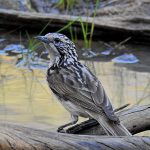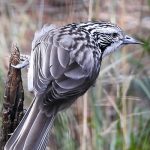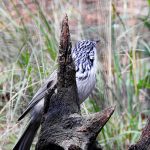STRIPED HONEYEATER
Plectorhyncha lanceolata
The Striped Honeyeater is native to Australia, and belongs to the family Meliphagidae. It is a medium-sized bird with distinctive plumage. It has a black crown and face, with white stripes extending from the eyes down to the nape of the neck. The rest of its body is mostly olive-brown with fine streaks on the underparts. Its bill is slender and slightly curved, which is adapted for feeding on nectar.
It is found in the eastern and south-eastern parts of Australia. Its range includes parts of Queensland, New South Wales, Victoria, and South Australia in a variety of habitats, including woodlands, forests, heathlands, and scrubby areas. They are often seen in eucalyptus woodlands and open areas with flowering plants.
Like many honeyeaters, the Striped Honeyeater primarily feeds on nectar from flowers. They also consume insects, spiders, and other small invertebrates, especially during the breeding season. They use their specialized brush-tipped tongue to extract nectar from flowers.
Striped Honeyeaters are known for their acrobatic flight patterns, which they use to access nectar from various flowers. They are often seen darting from flower to flower, probing for nectar. They are highly active and social birds, often foraging in small groups.
Breeding typically occurs from August to January. They build cup-shaped nests in shrubs or trees, and the female usually lays two to three eggs. Both parents participate in incubating the eggs and feeding the chicks.
Like many bird species, they face habitat loss and fragmentation due to human activities, which can impact their populations.



